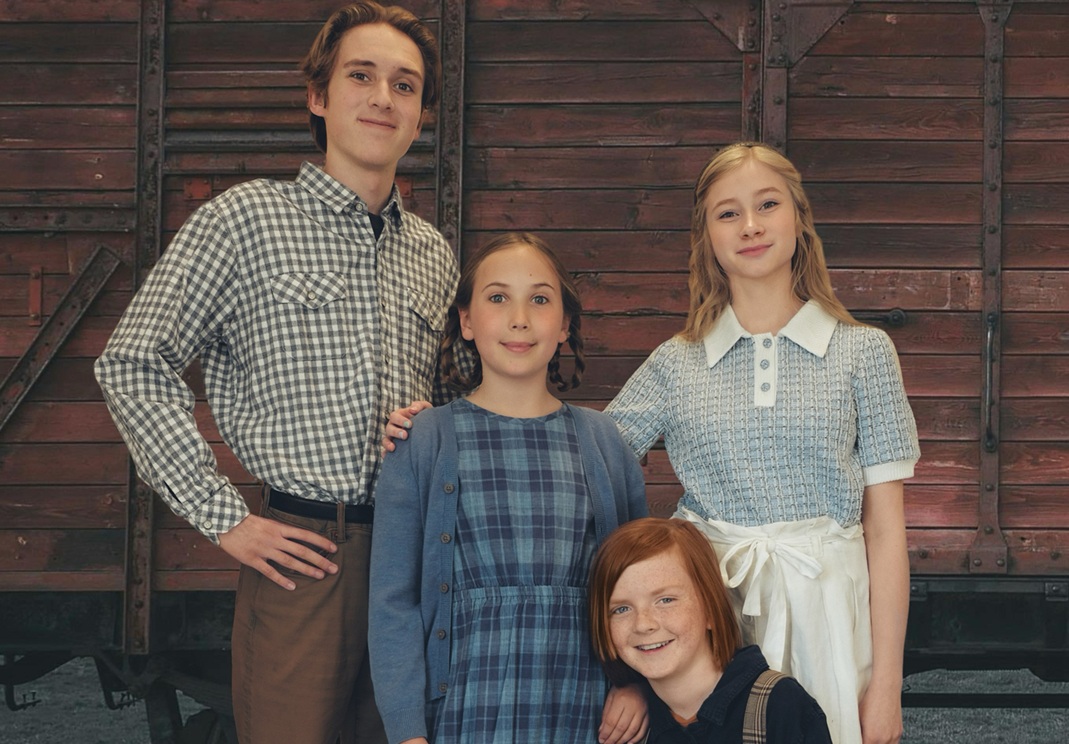PLEASANT GROVE — Time is a train that never ceases to move down the tracks. With each passing year, more works are created and more from the past enter the public domain. In 2020, the first of Gertrude Chandler Warner’s one-hundred and sixty-one Boxcar Children books passed from private to public ownership, and with it now comes Utah playwright Melissa Leilani Larson’s newest adaptation. The Box-Car Children is an hour-long one-act for young audiences that follows four orphans – Henry, Jess, Violet, and Benny – as they navigate a world newly absent of their parents.
This production, presented as part of Creekside Theatre Fest’s tenth anniversary season at Liahona Preparatory Academy, was warmly received by the young audience around me—my own 9-year-old included—and offered a story that genuinely connected with its viewers. At the center of the intimate blackbox space stood a large brown rectangular structure on a turning pivot, designed by Cannon Hadfield. This versatile set piece, rotated and reimagined throughout, allowed for a half dozen or so distinct settings with only minor changes—a brilliantly simple device for a story that moves through time and place. Jen Christensen’s crisp, period-appropriate costumes further established tone and class distinction with skill and subtlety. It was nice to see the simple distressing of the clothes of the orphaned children against the clean press of the other character’s outfits. I was, as I often am, taken with a truly delightful puppet for the dog – Watch – which was manipulated by many in the cast to great effect.

Larson’s script is tightly constructed, heartfelt, and true to the spirit of the original books. The “gosh-whiz, golly gee” charm of the children never feels cloying or outdated, and the story’s wholesome, can-do spirit glows with Americana warmth. In text, this play invites a layered emotional journey—rooted in hope despite loss, self-reliance, and ultimately reconciliation.
But somewhere between the page and the stage, a disconnect emerges.
While Larson’s script encourages nuance, director Blake Barlow’s direction often flattens characters into broad strokes. Take, for example, Hillary Straga and James Wakeland, who skillfully portrayed the warm and empathetic Dr. McAllister and his mother. Their performances in these roles were grounded and compelling—so much so that it was jarring to see the same actors play the Baker couple with such exaggerated villainy. Straga’s becomes the caricature of a mustache-twirling nemesis as the baker’s wife and Wakeland’s similarly cartoonish husband shifted the tone to something much more pantomime than parable. While this comedic landed some laughs, it felt out of sync with the sincerity of the rest of the story.
This tonal imbalance extended to the children themselves. As Henry and Jess, Gavin Ward and Taebria Bybee showed care and determination, but their performances rarely reflected the true gravity of their situation. Violet’s illness, the threat of being taken by the Bakers, or the uncertainty of life on their own all felt more like plot points than emotional stakes. Ward and Bybee are earnest and sincere throughout, but they rarely delve into the deeper emotional waters of their story’s reality. The script supports a more textured approach, but the performances often defaulted to a single emotional note—perhaps a result of direction that prioritized clarity over complexity.
Barlow’s direction was strongest in physical storytelling: the staging was clean and creative, and the relationships between characters felt thoughtfully blocked and well-paced. I loved the blocking that happened as Henry runs in the Field Day race as a prime example of Barlow’s skill in navigating a small space. Yet, the internal lives of the characters seemed underdeveloped, with few moments that invited the audience to feel the tension, fear, or doubt that the script points towards.
Even the story’s resolution—the children’s reunion with their long-feared grandfather—lacked some for dramatic payoff. Michael Smith played Mr. Cordyce with unshakable geniality, which made the children’s dread feel baseless. In this one case, it felt more like a place where the text can use further refinement because there was little to justify the children’s avoidance of a grandfather offering a massive reward to find the lost children. However, direction again could have led to a more complex or ambiguous portrayal that could have better supported the play’s central conflict and added dramatic tension to the play’s end. The family coming together with help from Dr. and Mrs. McAllister was still a lovely moment that wrapped the story nicely, but it lacked climactic tension.
The Box-Car Children’s world premiere was charming and delightful. Larson’s script feels like it will quickly become a staple for high school competition pieces and served as an enjoyable night out with my young son. For family theatre, that part may matter the most. In this production, many design and performance elements shine, and the audience’s delight is real. However, a more cohesive coupling between playwright and director—a shared vision for tone, character, and emotional depth—would have elevated the show from pleasant to profound.
[box]The Box-Car Children plays select dates as part of the Creekside Theatre Fest, running through June 22, 2024, at Liahona Preparatory Academy (2464 West 450 South, Pleasant Grove). Tickets and festival information are available at creeksidetheatrefest.org. [/box]
